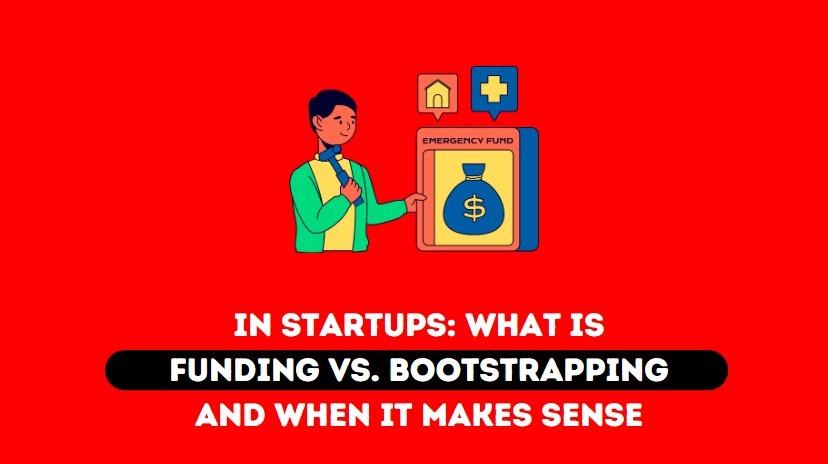Launching a successful startup is no small feat. Beyond conceptualizing an innovative product or service, founders must strategically assess how to finance their venture’s growth. Two common approaches are bootstrapping, relying on internal resources to self-fund operations, or seeking outside capital from investors. Both models have advantages and downsides. This article will break down key considerations around bootstrapping versus pursuing funding for startups.
What is Bootstrapping?
The term bootstrapping originated from the phrase “pulling oneself up by one’s bootstraps,” or succeeding through self-reliance and hard work. When applied to startups, it means growing primarily using founders’ personal finances, business revenue, loans from friends/family, or debt financing.
Bootstrapping offers full control and ownership retention, avoids dilution, and builds financial discipline by tying spending closely to revenues. Potential downsides are slower expansion, constrained hiring, and founders bearing full financial risk if the company fails. Roughly a third of startups bootstrap initially.
Reasons to Bootstrap
Desire for independence – Bootstrapping founders maintain complete authority over strategy and operations without investor oversight.
Need to prove concept – Generating an initial customer base and revenue traction can demonstrate market viability more persuasively before engaging investors.
No urgent capital needs – Some startups evolve gradually and organically, without heavy upfront investment into R&D or marketing before monetization.
Risk tolerance – Personal tolerance for risk varies greatly between founders. For risk-averse entrepreneurs, bootstrapping may feel safer.
When Bootstrapping Makes Sense
In general, companies which can incrementally advance products to market and organically attract customers often thrive the longest through bootstrapping. Examples include many small ecommerce brands, niche SaaS tools, and specialized consulting firms. If chasing investors detracts too severely from focusing on customers, sticking to internal financing is smart.
Seeking Outside Funding
While bootstrapping has its place, rapidly growing startups frequently require outside capital infusions. Common sources are angel investors, venture capital firms, corporate investors, and alternative online platforms like crowdfunding.
Investor money turbocharges expansion via aggressive customer acquisition costs, expensive R&D projects before profitability, generous talent recruitment packages, and overall acceleration of the founder’s strategic vision.
Downsides of outside funding include loss of control, heightened pressure to achieve venture-level returns, and compressed time horizons for major liquidity events. Investors also expect senior leadership changes if the startup struggles.
Reasons to Seek Funding
Growth imperatives – For many tech startups, attaining market leadership requires immense upfront investment to outpace rivals before monetization kicks in at scale years later.
Innovation demands it – Capital-intensive projects like biotech or hardware can’t advance without large funding rounds to finance long development cycles.
Investor expertise matters – Seasoned venture capitalists often augment startups with invaluable strategy advice, recruiting assistance, and access to key partners.
Hiring top talent – Competing for the very best employees may require substantial compensation and equity packages only possible with sizeable financing.
When Fundraising Makes Sense
Pursuing external investment tends to suit startups tackling ideas of unprecedented scope or complexity, like reinventing entire industries. It also accommodates highly competitive sectors dominated by well-capitalized incumbents. Finally, founders who prioritize hypergrowth over firm control benefit more from experienced investor guidance and resources.
Stages of Startup Funding
If seeking capital, startups pursue a series of ever-larger funding rounds tied to hitting key milestones. While terminology varies by industry, typical phases include:
Pre-Seed Round – Early capital to finalize product development and attract first talent. May include friends/family investors.
Seed Round – Funding to build initial prototypes, launch pilots, and demonstrate early traction to validate market fit. Angels participate here.
Series A Round – With proof-of-concept achieved, Series A attracts institutional venture capitalists to finance full customer acquisition, continued product enhancement, and operational scale-up.
Series B, C Rounds – Later rounds support geographic expansion, new products, strategic partnerships and M&A activity. Companies now have significant valuation.
IPO / Acquisition – End goal is either an initial public offering or lucrative exit via company sale. Investors realize substantial return on investment.
Choosing the Best Path Forward
In reality, startup funding versus bootstrapping constitutes more of a continuum than a binary choice. Many founders blend the two approaches over time. Initially bootstrapping through product development and first sales eliminates wasted capital. Once market traction manifests, shifting to external financing enables removing constraints on growth potential.
Rather than deciding at outset between self-funding and institutional venture money, staying flexible to pivot funding strategies based on market feedback is wise. Some questions that founders should ask when assessing financing options include:
- How patient can we be with growth timeline before profitability?
- What hiring and R&D investments are absolutely essential near term?
- Who owns customer relationship – investors or founders?
- How much control are we willing to cede to a board or VC partners?
- What metrics determine success – revenues or long-term value?
The freedom versus firepower decision confronting startups is far from straightforward. Striking the right balance requires thoughtful analysis of business model, personal risk tolerance, and desired pace of expansion. But with dynamism and resilience, young companies can thrive on either funding path.

